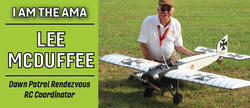Written by Patrick Sherman Advanced Flight Technologies Column As seen in the July 2017 issue of Model Aviation.Your drone has a camera on it, but that doesn’t necessarily make you an aerial photographer any more than owning a scalpel makes you a brain surgeon. The automatic settings that are preprogrammed into drones from manufacturers such as Yuneec, Autel Robotics, and DJI provide solid results in most environments. In fact, they do such a good job that many pilots never feel the need to change the default configuration. However, learning to manually control your camera’s operating parameters opens a world of possibilities.
I Shutter to Think
There are three basic functions you can adjust in your camera settings: shutter speed, ISO (also called gain), and exposure. Like a mathematical equation that must always be in balance, making a change to any one of these affects the other two, and you can’t always have everything you want. Shutter speed determines how long the imaging sensor is exposed to the environment. In decades past, the imaging sensor was a strip of clear plastic, coated with a gelatin emulsion containing light-sensitive silver halide crystals—otherwise known as film. The shutter was an actual, mechanical device like an opaque window blind that could be opened and shut in precise increments of time. Electronics have replaced both of those elements in modern cameras, but the fundamental principles remain.Image

Image

These two images, captured using a handheld camera, demonstrate both the potential and the peril of opening the shutter for a longer duration to create motion blur. Notice in the top image how the body of the helicopter is in sharp focus, but the spinning propellers are blurred, revealing their movement even in a still photograph. In the image below, the photographer moved the camera while the shutter was open, ruining the image.
Open the shutter for a longer period of time and you allow more light to fall on the sensor. However, you also create the possibility of motion blur, which occurs when your subject, or the camera, moves perceptibly during the interval that the shutter is open. Motion blur can be either friend or foe—it can create a sense of thrilling speed, or make your subject appear to be out of focus. It depends on what you’re trying to achieve. If you want the subject to be sharp, you will select a very fast shutter speed, perhaps 1/1000 second. One problem that might come from this choice, though, is that such a fast exposure will not allow enough light to reach the imaging sensor, and your image will appear dark or underexposed. That is an example of the tradeoffs that are inherent in photography.
Image

In this image, the photographer attempted to reveal the movement of the helicopter’s rotor blades by leaving the shutter open long enough to create a motion blur. However, it also allowed more light to fall on the image sensor, resulting in an overexposed picture. This photo was taken from the ground.
Don’t Be So Sensitive
In addition to shutter speed, there is another option available to us: adjusting the ISO, or gain, of the sensor. This means altering how sensitive the sensor is to the light that is falling on its surface. This is another concept left over from the days of mechanical cameras. Film was sold at different ISO ratings, which varied the size of the silver halide crystals in the emulsion—the larger the crystals, the greater the sensitivity to light. The least sensitive film typically has an ISO rating of 100, while the most sensitive is 3,200 ISO or higher. However, there is once again a tradeoff inherent to choosing an ISO. As ISO increases, so does the grain (noise) in the image. This was originally a result of the larger crystals used in high-ISO film, but the same fundamental limitations remain, even in an all-digital world. Like motion blur, grain isn’t necessarily the enemy. It is used effectively to create a gritty aesthetic in war movies. Most digital editing software allows you to artificially add grain to your images to create that effect. However, we’re still looking for that extremely sharp photo, such as the one on the cover of this month’s issue of Model Aviation. How much grain you see at different ISO settings varies between camera manufacturers, so you will need to experiment to determine what level of grain is acceptable to you.Image

Successful photography relies on an understanding of the fundamental tradeoffs between shutter speed, ISO, and exposure. However, when the photographer succeeds in finding a balance between these factors, the results can be magical, as seen in this ground-based image.
If an ISO of 400 is as high as you feel comfortable going at 1/1000 second, and your image is still coming out underexposed, your only option is to add more light by waiting for a sunny day, changing the position of your subject relative to the sun, or using artificial light. Most larger, purpose-built cameras—unlike those you find on cellphones and prosumer-level drones—give you another option of opening up the aperture. Aperture is a fancy word for the opening in the lens where light comes through. Make it bigger and you let more light fall onto the sensor. The size of the hole is reflected by the f-stop of the lens, with f/2 being a big hole, and f/22 being a tiny hole. However, adjusting the f-stop of the lens involves another set of tradeoffs and isn’t an option on most drone cameras, unless you’re flying a professional-grade aerial cinema rig. In that case, you became bored and stopped reading a few minutes ago.







Comments
Beginning photography (aerial)
Good overview. Now I have to find someone knowledgeable in setting the Typhoon H camera.
Add new comment